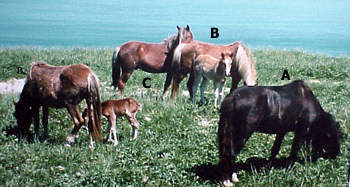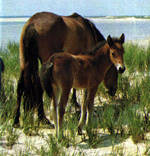| |
|
 |
Social behaviour
Sable's horses were once domestic. As they became
wild, they went back to their natural social system of
small herds, each defended by a stallion.

|
Herds
- about 6
animals: A. one stallion B. mares and
their young C. bachelor males sometimes tag along
- 40 to 50 herds
on the island
- bachelor males may form herds
- each herd has a home range of about 3 square km
- family herds avoid each other, even at shared water
holes
| To protect
their breeding rights, stallions must constantly
defend their mares by threatening other males. This
may lead to fierce fights. |
|
 |
Most
young are born in May or June, after nearly a year
in the womb and will nurse for 10 months |
| A herd
huddles together in the shelter of the dunes. |
|
Death
|
|
Death
from natural causes prevents the island from becoming
over-populated. After several mild winters the population
increases, but many of the old, weak or very young
animals will die during the next hard winter. |
| |
 |
|
The
number of horses changes from year to year.
|
Nutrients from dead horses enrich the soil, encouraging
a lush growth of Marram. |
|
Home
| Nature | History
| Sable Today | Fun
| About | Feedback
| Franšais
|









